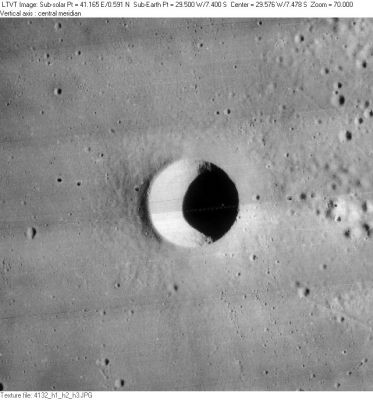Euclides
Contents
Euclides
|
Lat: 7.4°S, Long: 29.5°W, Diam: 11 km, Depth: 2.57 km, [/R%C3%BCkl%2041 Rükl 41] |
Table of Contents
[#Euclides Euclides]
[#Euclides-Images Images]
[#Euclides-Maps Maps]
[#Euclides-Description Description]
[#Euclides-Description: Elger Description: Elger]
[#Euclides-Description: Wikipedia Description: Wikipedia]
[#Euclides-Additional Information Additional Information]
[#Euclides-The yellow spot north of Euclides M The yellow spot north of Euclides M]
[#Euclides-Nomenclature Nomenclature]
[#Euclides-LPOD Articles LPOD Articles]
[#Euclides-Bibliography Bibliography]

LO-IV-132H
Images
LPOD|Photo Gallery images Lunar Orbiter Images Apollo Images
Maps
([/LAC%20zone LAC zone] 76A4) LAC map Geologic map LM map AIC map
Description
Description: Elger
([/IAU%20Directions IAU Directions]) EUCLIDES.--One of the most brilliant objects on the moon; a crater 7 miles in diameter, standing on a large bright area in the [/Oceanus%20Procellarum Mare Procellarum], W. of [/Montes%20Riphaeus The Riphaean Mountains]. Its W. rim rises nearly 2,000 feet above the bright depressed floor; on the E. there is a bright little unrecorded crater.
Description: Wikipedia
Additional Information
- Depth data from [/Kurt%20Fisher%20crater%20depths Kurt Fisher database]
- Westfall, 2000: 2.57 km
- Viscardy, 1985: 1 km
- Cherrington, 1969: 1.34 km
- From the shadows in LO-IV-132H, Euclides is about 2600 m deep.
- Euclides and its satellite craters C and M are on [/ALPO%20list%20of%20bright%20ray%20craters ALPO list of bright ray craters]
- Euclides and Euclides D ("Eppinger") are thermal anomaly craters, implying youthful ages - [/Moore%20et%20al%2C%201980 Moore et al, 1980]
- [/Mutch%2C%201970 Mutch, 1970] (p. 66, Figure IV-5) offers Euclides, along with [/M%C3%B6sting Mösting] C and [/Censorinus Censorinus], as examples of a class of fresh craters with "circular plan views, simple cup-like profiles, sharply raised rims, and prominent surrounding ejecta, frequently with a hummocky inner facies and a radial outer facies." [/M%C3%B6sting Mösting] C is noted as having a somewhat flat floor when examined in detail. It is unclear if the [/sun%20angle sun angle] in any of the [/Lunar%20Orbiter Lunar Orbiter] or [/Apollo%20program Apollo] photos of Euclides were high enough to reveal details about its central floor. The Clementine mosaics clearly indicate Euclides has a flat floor and probably a conical shape. - JimMosher JimMosher
- TSI = 5, CPI = 5, FI = 5; MI =15 [/Smith%20and%20Sanchez%2C%201973 Smith and Sanchez, 1973]
The yellow spot north of Euclides M
- The southern part of Montes Riphaeus seems to show a yellow spot, just north of the high-albedo bowl shaped crater Euclides M, see the LROC's WAC-albedo/color map; close up of the Euclides M region: http://bit.ly/1EdZ5m1
Nomenclature
Euclid; Greek mathematician (unkn-c. 300 B.C.).
- According to [/Whitaker Whitaker] (p. 219), this name was introduced by [/M%C3%A4dler Mädler].
- Euclides D was once known as Eppinger.
- Was Euclides M called Zeno? (see Whitaker, page 164, Figure A; nomenclature of J.N.Krieger).
LPOD Articles
Bibliography
This page has been edited 1 times. The last modification was made by - tychocrater tychocrater on Jun 13, 2009 3:24 pm - afx3